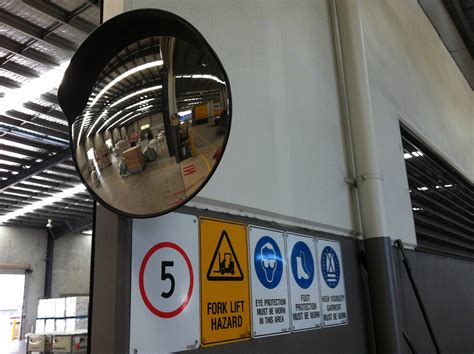The concept of a safety mirror is multifaceted, encompassing a range of technologies and applications designed to enhance safety in various environments. At its core, a safety mirror is a device or system that provides a clear and comprehensive view of an area, allowing individuals to detect potential hazards or obstacles that might not be visible through direct line of sight. This can be particularly crucial in settings such as workplaces, public spaces, and transportation systems, where the ability to anticipate and respond to safety risks can significantly reduce the likelihood of accidents and injuries.
One of the primary applications of safety mirrors is in the context of industrial and workplace safety. In environments where forklifts, trucks, and other large machinery are in operation, safety mirrors can be installed at intersections, blind corners, and other areas where visibility is limited. These mirrors are typically convex, providing a wide-angle view that allows drivers and pedestrians to see around corners and anticipate potential collisions. By enhancing visibility and reducing blind spots, safety mirrors play a critical role in preventing accidents and ensuring a safer working environment.
Key Points
- Safety mirrors enhance visibility and reduce blind spots in various environments.
- Convex safety mirrors are commonly used in industrial settings to provide a wide-angle view.
- Safety mirrors can be used in conjunction with other safety measures, such as warning signs and alarms.
- Regular maintenance and inspection of safety mirrors are crucial to ensure their effectiveness.
- Safety mirrors can be adapted for use in different settings, including public spaces and transportation systems.
Types of Safety Mirrors

There are several types of safety mirrors available, each designed to address specific safety needs and applications. Convex mirrors, as mentioned, are widely used in industrial settings due to their ability to provide a broad field of view. However, other types of mirrors, such as domed mirrors and two-way mirrors, can also be used for safety purposes. Domed mirrors, for example, offer a 360-degree view and are often used in security applications to monitor areas such as parking garages or public restrooms. Two-way mirrors, on the other hand, allow for observation from one side while appearing as a regular mirror from the other, and are sometimes used in training or surveillance contexts.
Installation and Maintenance Considerations
The effective use of safety mirrors depends not only on their type and quality but also on their proper installation and maintenance. When installing safety mirrors, it is essential to consider the height, angle, and position of the mirror to ensure that it provides the best possible view of the area in question. Regular cleaning and inspection of the mirror are also crucial to maintain its effectiveness, as dust, dirt, or other obstructions can significantly reduce its usefulness. Furthermore, safety mirrors should be inspected periodically for signs of damage or wear, and replaced as needed to ensure that they continue to provide a clear and reliable view.
| Category | Description |
|---|---|
| Convex Mirrors | Wide-angle view, commonly used in industrial settings. |
| Domed Mirrors | 360-degree view, used in security and surveillance applications. |
| Two-Way Mirrors | Allows for observation from one side, used in training and surveillance contexts. |

Technological Advancements and Future Directions

While traditional safety mirrors continue to play a vital role in enhancing safety, technological advancements are opening up new possibilities for safety mirror systems. The integration of digital technologies, such as cameras and sensors, into safety mirror systems can provide real-time monitoring and alert systems, further enhancing safety and reducing the risk of accidents. Additionally, the development of smart safety mirrors that can detect and respond to specific safety risks, such as pedestrians or vehicles, is an area of ongoing research and innovation. As these technologies continue to evolve, it is likely that safety mirrors will become even more sophisticated and effective tools for enhancing safety in a wide range of applications.
Implications for Public Spaces and Transportation Systems
The use of safety mirrors is not limited to industrial settings; they also have significant implications for public spaces and transportation systems. In areas such as shopping malls, airports, and train stations, safety mirrors can be used to enhance visibility and reduce the risk of accidents. Similarly, in transportation systems, such as buses and trains, safety mirrors can be used to provide drivers with a clear view of their surroundings, reducing the risk of collisions and enhancing passenger safety. As urban populations continue to grow and public spaces become increasingly complex, the role of safety mirrors in maintaining safety and preventing accidents will only continue to expand.
What is the primary purpose of a safety mirror?
+The primary purpose of a safety mirror is to provide a clear and comprehensive view of an area, allowing individuals to detect potential hazards or obstacles that might not be visible through direct line of sight.
What types of safety mirrors are available?
+There are several types of safety mirrors available, including convex mirrors, domed mirrors, and two-way mirrors, each designed to address specific safety needs and applications.
How often should safety mirrors be inspected and maintained?
+Safety mirrors should be inspected and maintained regularly to ensure their effectiveness. This includes cleaning the mirror, checking for signs of damage or wear, and replacing the mirror as needed.
In conclusion, safety mirrors play a critical role in enhancing safety in various environments, from industrial settings to public spaces and transportation systems. By providing a clear and comprehensive view of potential hazards, safety mirrors enable individuals to take proactive measures to prevent accidents and ensure a safer environment for everyone. As technological advancements continue to evolve, it is likely that safety mirrors will become even more sophisticated and effective tools for maintaining safety and preventing accidents.
